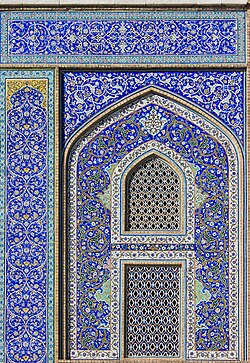Khorasani style
The Khorasani style (Persian: شیوه معماری خراسانی, IPA: /sæbk ɛ xoɾɑsɑni/) is an architectural style (sabk) defined by Mohammad Karim Pirnia when categorizing Iranian architecture development in history. It is the first style of architecture appearing after the Muslim conquest of Persia, but is highly influenced by pre-Islamic designs.[1] Landmarks of this style appear in the late 7th century, and span through the end of the 10th century CE.[2]
Examples of this style are Mosque of Nain, Tarikhaneh-i Damghan, and Jame mosque of Isfahan
Gallery[]

Mosque of Nain: Na'in has one of Iran's oldest mosques still standing.
Ardestan Congregation Mosque
See also[]
References[]
- ^ Fallāḥʹfar, Saʻīd (Persian: سعید فلاحفر). The Dictionary of Iranian Traditional Architectural Terms (Farhang-i vāzhahʹhā-yi miʻmārī-i sunnatī-i Īrān فرهنگ واژههای معماری سنتی ایران). Kamyab Publications (Persian: انتشارات کامیاب). Kāvushʹpardāz. 2000, 2010. Tehran. ISBN 978-964-2665-60-0 US Library of Congress LCCN Permalink: [1] pp.44
- ^ Sabk Shenasi Mi'mari Irani (Study of styles in Iranian architecture), M. Karim Pirnia. 2005. ISBN 964-96113-2-0 pp.134-135
External links[]
Categories:
- Architecture of Iran



